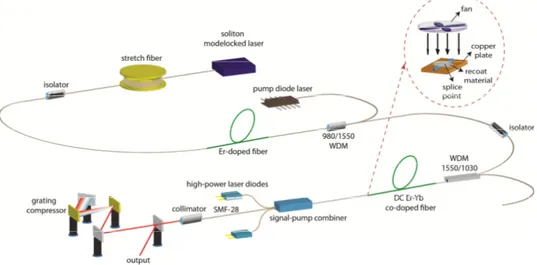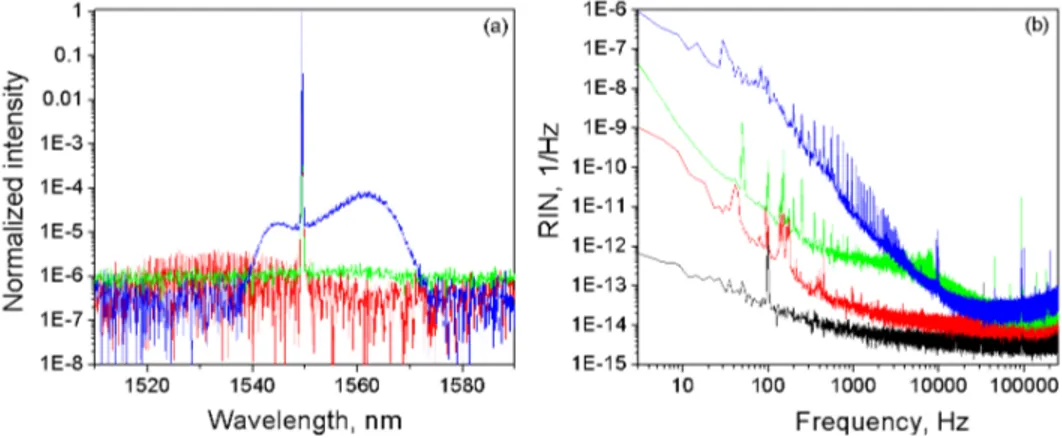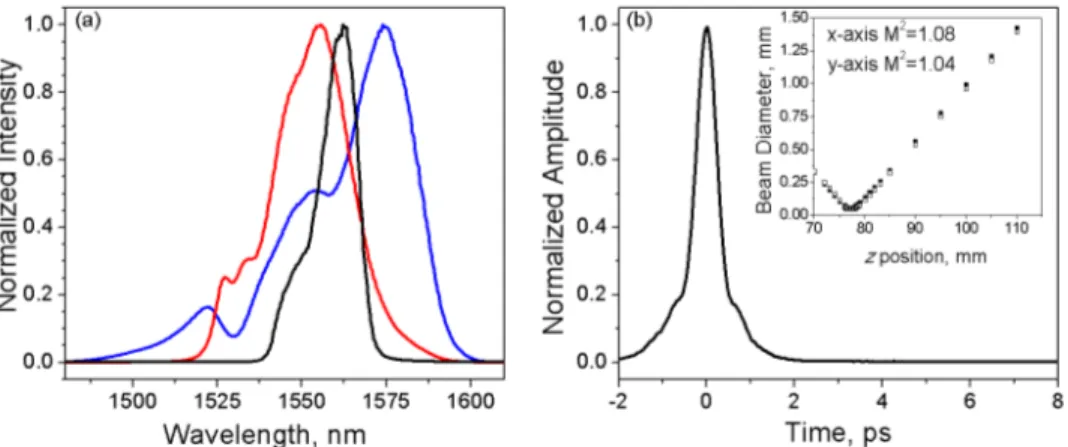High-power high-repetition-rate single-mode
Er-Yb-doped fiber laser system
Ihor Pavlov,1,4,* Emrah Ilbey,1 Ebru Dülgergil,2,3 Alper Bayri,1 and F. Ömer Ilday1 1Department of Physics, Bilkent University, 06800 Ankara, Turkey
2Meteksan Savunma, AS, 06531, Ankara, Turkey
3Department of Physics, Middle East Technical University, 06531, Ankara, Turkey
4Permanent address: Institute of Physics of National Academy of Sciences of Ukraine, Kyiv 680028, Ukraine *pavlov@fen.bilkent.edu.tr
Abstract: We demonstrate an all-fiber-integrated, high-power chirped-pulse-amplification system operating at 1550 nm. The seed source is a soliton fiber laser with 156 MHz repetition rate. Two-stage single mode amplifier provides an amplification of more than 40 dB without significant spontaneous amplified emission. The power amplifier is based on cladding-pumped 10 µm-core Er-Yb co-doped fiber, the output of which was spliced into standard singlemode fiber. We obtain 10 W average power in a strictly singlemode operation. After dechirping with a grating compressor, near transform-limited, 450 fs-long pulses are obtained. The laser source exhibits excellent short and long-term intensity stability, with relative intensity noise measurements characterizing the short-term stability.
©2012 Optical Society of America
OCIS codes: (140.4050) Mode-locked lasers; (060.2320) Fiber optics amplifiers and oscillators.
References and links
1. D. J. Richardson, J. Nilsson, and W. A. Clarkson, “High power fiber lasers: current status and futures perspectives [Invited],” J. Opt. Soc. Am. B 27(11), B63–B87 (2010).
2. O. Lumholt, T. Rasmussen, and A. Bjarklev, “Modelling of extremely high concentration erbium-doped silica waveguides,” Electron. Lett. 29(5), 495–496 (1993).
3. Y. Jeong, S. Yoo, C. A. Codemard, J. Nilsson, J. K. Sahu, D. N. Payne, R. Horley, P. W. Turner, L. Hickey, A. Harker, M. Lovelady, and A. Piper, “Erbium:Ytterbium co-doped large core fiber laser with 297-W continuous-wave output power,” IEEE J. Sel. Top. Quantum Electron. 13(3), 573–579 (2007).
4. B. Morasse, S. Agger, C. Hovington, S. Chatigny, É. Gagnon, J.-P. de Sandro, and C. Poulsen, “10W ASE-free single-mode high-power double-cladding Er3+-Yb3+ amplifier,” Proc. SPIE 6453, 645324 (1–8) (2007). 5. J. C. Jasapara, M. J. Andrejco, J. W. Nicholson, A. D. Yablon, and Z. Várallyay, “Simultaneous direct
amplification and compression of picosecond pulses to 65-kW peak power without pulse break-up in erbium fiber,” Opt. Express 15(26), 17494–17501 (2007).
6. J. C. Jasapara, A. DeSantolo, J. W. Nicholson, A. D. Yablon, and Z. Várallyay, “Diffraction limited amplification of picosecond pulses in 1170 microm2 effective area erbium fiber,” Opt. Express 16(23), 18869– 18874 (2008).
7. J. C. Jasapara, M. J. Andrejco, A. D. Yablon, J. W. Nicholson, C. Headley, and D. DiGiovanni, “Picosecond pulse amplification in a core-pumped large-mode-area erbium fiber,” Opt. Lett. 32(16), 2429–2431 (2007). 8. J. C. Jasapara, M. J. Andrejco, A. DeSantolo, A. D. Yablon, Z. Vrallyay, J. W. Nicholson, J. M. Fini, D. J.
DiGiovanni, C. Headley, E. Monberg, and F. V. DiMarcello, “Diffraction limited fundamental mode operation of core-pumped very-large-mode-area Er fiber amplifiers,” IEEE J. Sel. Top. Quantum Electron. 15(1), 3–11 (2009).
9. M. E. Fermann, A. Galvanauskas, and M. Hofer, “Ultrafast pulse sources based on multi-mode optical fibers,” Appl. Phys. B 70(S1), S13–S23 (2000) (and references therein).
10. F. Morin, F. Druon, M. Hanna, and P. Georges, “Microjoule femtosecond fiber laser at 1.6 microm for corneal surgery applications,” Opt. Lett. 34(13), 1991–1993 (2009).
11. I. L. Budunoğlu, C. Ulgüdür, B. Oktem, and F. Ö. Ilday, “Intensity noise of mode-locked fiber lasers,” Opt. Lett. 34(16), 2516–2518 (2009).
12. K. Gürel, P. Elahi, Ç. Şenel, P. Paltani, and F. Ö. Ilday, “Influence of modulation of pump and seed signals on fiber amplification of broadband pulses,” in CLEO:2011 - Laser Applications to Photonic Applications, OSA Technical Digest (Optical Society of America, 2011), paper CThU5.
#163069 - $15.00 USD Received 15 Feb 2012; revised 26 Mar 2012; accepted 27 Mar 2012; published 10 Apr 2012
13. R. P. Scott, C. Langrock, and B. H. Kolner, “High dynamic range laser amplitude and phase noise measurement techniques,” IEEE J. Sel. Top. Quantum Electron. 7(4), 641–655 (2001).
1. Introduction
In the past decade, fiber lasers have emerged as one of the most rapidly developing branches of applied physics. There are several main reasons for this, including robust and free adjustment operation, high average power, which has exceeded multi-kW level for cw operation with high beam quality [1]. Quick progress was driven also by a correspondingly impressive development of low-cost, high-brightness, fiber-coupled pump diodes as pump sources, enabling development of compact systems with extremely high efficiency. Much of the activity in development of high-power fiber laser systems has concentrated on Yb-doped fibers, where normal material dispersion at this wavelength is advantageous in management of nonlinear effects for ultrashort pulses. There is demand for high-power, practical and low-cost Er-doped fiber laser systems, operating at 1550 nm wavelength. Operation at this wavelength is attractive for several reasons: The wavelength is in the eye-safe region and second-harmonic generation of 1550 nm is excellent for seeding Ti:sapphire amplifiers. There are also niche applications, such as ultrafast processing of silicon for photovoltaics, or corneal tissue surgery, where the high transparency of the material at 1.5-1.6 µm is an advantage. Finally, compared to 1-µm sources, it is better suited to seeding mid-IR parametric amplifiers and oscillators. However, to date, Er-doped fiber amplifier systems (EDFA) have lagged behind Yb-doped fiber amplifier systems (YDFA) in terms of efficiency and power. The main reasons include the much larger quantum defect for conventional 980 nm pumping, relatively smaller absorption cross-section, and impossibility to achieve high doping concentration [2], which, in turn, requires the use of long fibers, strengthening nonlinear effects. A possible solution is to use Er-Yb co-doping, which allows significantly increase of the pump absorption [1]. In this case, pump energy is first absorbed by Yb ions and then transferred non-radiatively to Er ions. The main drawback of this approach is the possibility of amplified spontaneous emission (ASE) generation at 1030 nm at high pump powers, which sharply decreases efficiency at 1550 nm and limits the output power level. Despite these difficulties, 297 W of CW power was achieved by using Er-Yb co-doped double-clad (DC) large mode area fiber [3]. In Ref [4], the authors demonstrated the possibility to reach about 10 W cw output power in single mode operation with a beam quality M2~1. In order to manage the nonlinear effects, which are strengthened by the anomalous dispersion of fibers at 1550 nm, one approach is to use large mode area (LMA) fibers, in spite of the difficulty to maintain high beam quality [5–8]. In Ref [8], the authors demonstrated amplification to ~2.8 W at 15 MHz repetition rate and M2 < 1.1 by using LMA fibers, which were pumped by Raman fiber lasers operating at 1480 nm. High-energy amplification to the µJ-level has been demonstrated by several groups at this wavelength range at low average powers and with amplifier configurations, which are not all-fiber-integrated [9,10]. It is desirable to achieve higher powers with truly singlemode output, thus eliminating need for special fiber treatment.
Here, we report on the development of an all-fiber master-oscillator power-amplifier (MOPA) system, where the power amplifier is based on DC Er-Yb co-doped fiber. The system produces more than 10 W of average output power at 156 MHz repetition rate. Even though we use a quasi-singlemode gain fiber, the amplifier output is extracted through a fiber collimator comprising of pure singlemode fiber (Corning SMF-28) and absolutely no effort, such as fiber coiling, is applied to the gain fiber. To the best of our knowledge, this is the highest average power ultrafast fiber amplifier at 1550 nm with truly singlemode output.
2. Experimental setup
The experimental setup is shown schematically in Fig. 1. As seed source, we use a passively mode-locked Er-doped fiber laser, which operates in the soliton regime with a repetition rate of 156 MHz. The pulses are extracted through a 5% fiber coupler; traverse an 80 m-long
#163069 - $15.00 USD Received 15 Feb 2012; revised 26 Mar 2012; accepted 27 Mar 2012; published 10 Apr 2012
segment of stretcher fiber with normal dispersion (D = −44 ps/nm.km). The stretched pulse duration is estimated to be 40 ps. After stretching, the signal is amplified in a 1.2 m-long Er-fiber, which is core-pumped by a singlemode pump diode operating 976 nm. The last stage of amplifier is a 6 m-long DC Er-Yb-codoped fiber with 10 µm core and 125 µm cladding diameter (Coractive Inc.), which is backward-pumped in the cladding by two high-power fiber-coupled multimode diodes at 976 nm through a signal-pump combiner. A 1030/1550 wavelength division multiplexer (WDM) is placed before the power amplifier to extract and observe any 1-µm ASE, which may be propagating in the backward direction. The fiber of the signal port of the combiner and the output collimator are SMF-28, which is purely singlemode at 1.5 µm. The pulses from the amplifier were dechirped in a grating compressor with groove density of 600 lines/mm. The amplifier system was also tested in CW mode. In CW configuration, we used a commercial single-frequency CW laser source centered at 1550 nm instead of the soliton oscillator (not shown in Fig. 1). The specified linewidth of the source is <10 kHz, which was separately verified through heterodyne beat measurements.
Fig. 1. Schematic of the experiment setup for pulsed operation. WDM: wavelength division multiplexer. Inset: the cooling system of the splice point between DC Er-Yb co-doped gain fiber of amplifier and passive DC fiber.
Active cooling is often needed for the gain fiber in high-power amplifiers, especially for the splice point when utilizing backward pumping, where both pump and signal powers are at maximum value. The cooling scheme is even more important for Er-doped amplifiers, for which the quantum defect is much larger than for Yb-doped systems, resulting in additional heating of the fiber. In our case, we employed simple air cooling (Fig. 1). A short section of the fiber near the splice point was glued to a copper plate by a UV curable polymer, which was cooled with a fan.
3. Results and discussion
At first, we investigated our system in CW operating mode. The input seed signal power to the preamplifier was typically around 10 mW. However, it was found that even 1 mW of seed power is enough to saturate preamplifier. The output power of preamplifier was 80 mW (the optical efficiency was around 30%), and this signal was used as seed for the power amplifier. The slope efficiency of the power amplifier was around ~40% upon first construction, and the maximum output power which we reached was 12 W, but it dropped to ~36% after several tens hours of operation and was stable afterwards. Several different copies of the amplifier were also constructed in our laboratory. We have found that the time of this reduction depends on the quality of the splice between gain fiber and passive fiber of combiner as well
#163069 - $15.00 USD Received 15 Feb 2012; revised 26 Mar 2012; accepted 27 Mar 2012; published 10 Apr 2012
as on the quality of the cooling system of the gain fiber, especially near the splice point. Therefore, the deterioration is at least partially due to degradation of the coating and is not caused entirely by the usual process of photodarkening. However, after this reduction, the amplifier stabilizes, apparently indefinitely, at 10 W. We believe the output power can be increased further, but in our experiments, we are limited by the power handling capability of the signal-pump combiner, which has two pump ports with a maximum specified power of 15 W per port. The output spectra of the seed, the preamplifier and the power amplifier are shown in Fig. 2(a). ASE suppression at 10 W output power is 40 dB, limited by the resolution of the spectrometer (~0.05 nm), which cannot fully resolve the linewidth of the CW signal. Taking this into account, the actual suppression is estimated to be ~70 dB. According to specification of our spectrum analyzer the measurement level range is −85 to + 10 dBm, and taking into account our measurement setup, even ~1 µW level could be detectable. However, unlike previous reports [4], we did not observe any spurious ASE at 1 µm at this pump power in neither the forward nor the backward direction (as monitored through the 1030 port of the WDM).
Fig. 2. The experimental characterization of the amplifier system working in the CW mode: (a) Measured optical spectrum of the seed source (red line), preamplifier output (green line), and power amplifier output (blue line). (b) RIN level of the seed (red line), preamplifier (green line), power amplifier (blue line), and noise floor (black line).
One of the most important parameters of an amplifier system is the level of output power variations. Long-term stability is typically determined by stability of the current provided to the pump diodes and the temperature stability of the entire setup, which can be improved using well-known experimental precautions. On the other hand, short-term stability (<1 s) is a complex property, which depends intrinsically on the laser dynamics as well as environmental factors, such as temperature variations and vibrations. This is particularly true in the sub-millisecond time scale (>1 kHz offset frequencies), where environmental effects do not play a significant role [11,12]. In our case, there are two main contributions to noise. The noise level of the seed signal, which can be further degraded in the amplifier, and the noise added in the amplifier, which is transferred from the pump source, especially for high power multimode diodes due to mode beating, as well as any ASE formed during amplification. According to [12], the pump noise contribution is important at frequencies below 5-10 kHz, i.e., for fluctuations much slower than the upper state lifetime of the Er ions. We have characterized the relative intensity noise (RIN) of our system using the standard technique [13]. Figure 2(b) shows measured RIN from the seed source as well as the preamplifier and power amplifier outputs. The integrated RIN at 10 W of output power is 0.4% (0.018%) over the range of 3 Hz - 250 kHz (1 kHz - 250 kHz). The noise level in the 1 kHz - 250 kHz range is largely free of environmental effects and the measured low value indicates quite high intrinsic stability.
#163069 - $15.00 USD Received 15 Feb 2012; revised 26 Mar 2012; accepted 27 Mar 2012; published 10 Apr 2012
Next, we have characterized the pulsed operation of the amplifier system. The average power of the seed pulses from the soliton fiber laser is about 1 mW after the stretcher fiber, with a corresponding energy of only 6.4 pJ. Thus, a preamplifier is necessary to boost the power up to 100 mW. After the power amplifier, the pulse energy is increased to 64 nJ at 156 MHz. The output spectra of the seed, preamplifier and power amplifier output are shown in Fig. 3(a). The pulse train is checked against multiple pulsing using a high-speed photodetector connected to an RF spectrum analyzer (with a combined bandwidth of 12 GHz) and a long-range (60 ps) autocorrelator. The net gain factor of the system is ~40 dB, and including the losses due to components and splices, the actual amplification factor is estimated to be >50 dB. As a result, we observe significant gain narrowing. After dechirping with a diffraction grating compressor, the pulses are characterized via intensity autocorrelation (Fig. 2(b)). The efficiency of the compressor is 25% owing to the poor quality of the grating. The full-width at half-maximum pulse duration is inferred to be 450 fs, assuming a Gaussian pulse shape. The pulse width is nearly twice the transform-limited pulse duration, which is limited by the onset of the self-phase modulation in the amplifier, as well as mismatch of third-order dispersion from the fiber stretcher and the grating compressor. The amplifier output shows excellent long-term stability in power, spectral shape and autocorrelation trace.
Fig. 3. (a) Measured optical spectrum of the seed (blue line), preamplifier (red line) and power amplifier output at 10 W (black line). (b) Intensity autocorrelation of the dechirped pulses at full amplifier output. Inset: Dependence of beam diameter at the 1/e-level on position, along with fitted M2 values.
Finally, the beam quality also was verified, and the M2 result is presented in Fig. 3. It confirms the excellent spatial properties of the beam with an M2 value of 1.06.
4. Conclusions
In conclusion, we have demonstrated an all-fiber-integrated oscillator-amplifier system comprising of a 156-MHz oscillator operating in the soliton regime and seeding a fiber amplifier. Beam propagation everywhere in the system is in optical fiber and fiberized components until the final grating compressor. As such, the system is completely free of misalignment. The amplifier generates 10 W of average power at the collimator output, which is comprised of SMF-28. Therefore, the output is truly single-mode and diffraction limited. After dechirping, the pulse duration is 0.45 ps. We expect this system to be of use in various applications requiring high-power, high-repetition-rate pulses at an eye-safe wavelength.
Acknowledgements
This work is supported by the SANTEZ Project No. 00255.STZ.2008-1.
#163069 - $15.00 USD Received 15 Feb 2012; revised 26 Mar 2012; accepted 27 Mar 2012; published 10 Apr 2012


